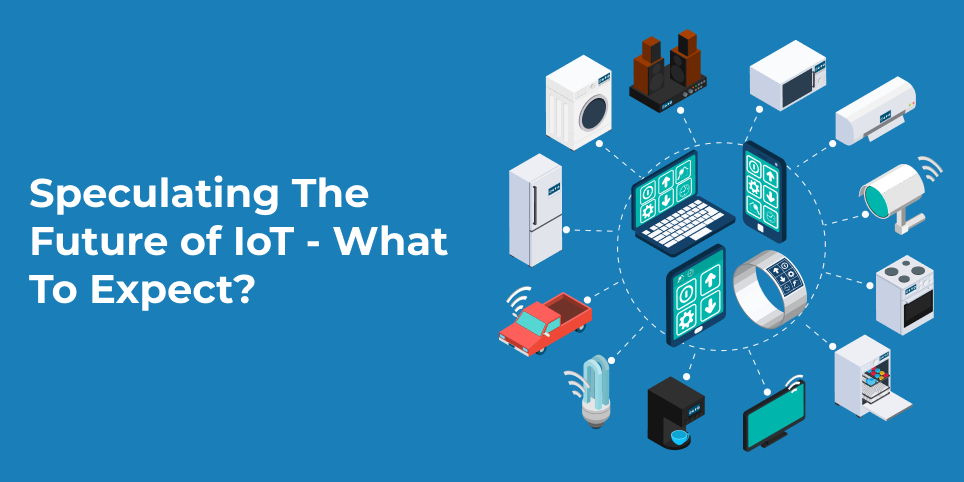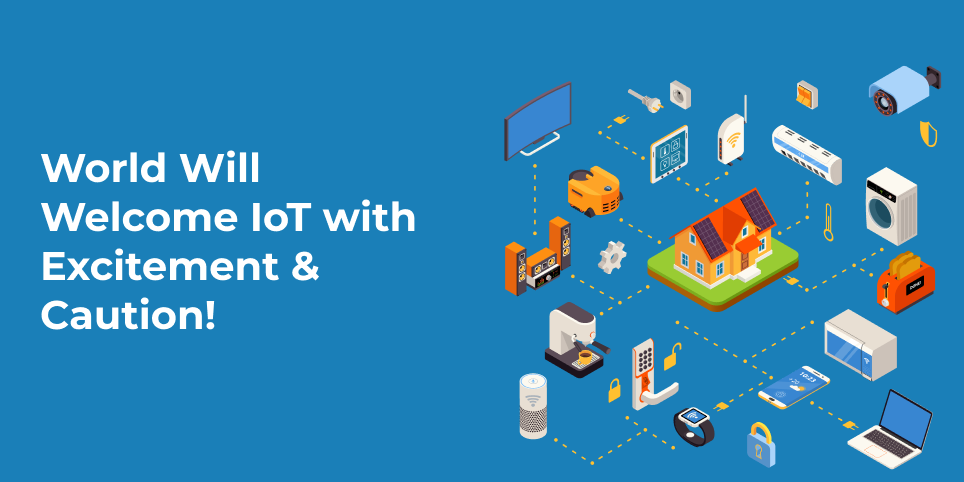
Speculating The Future of IoT – What To Expect?
IoT is set to showcase the limitless potential in the future. The improvised network agility, and the ability to deploy, orchestrate, automate, and secure varied use cases at scale in integration with artificial intelligence has accelerated the movement in the industrial internet.
It is not just about empowering billions of devices together, but it is about harnessing large volumes of actionable data that automates several business processes. As we see the networks and IoT platforms getting evolved to resolve the challenges with enhanced capacity, the service providers are working harder to keep themselves at an edge over their competitors. This has triggered newer streams of revenue generation.
World Will Welcome IoT with Excitement & Caution!

The future of IoT applications is emerging with an exciting wave because it is powered by intuitive human skills that are transferred into machines. Humans will be able to interact in real-time over great distances not with each other but with machines too. These sensory experiences will be similar to those that they experience at a local level A new wave of opportunities is going to come up within the streams of surgery, repair, and remote learning. Immersive experiences are to become the next platform just after mobile.
As the internet landscape is expanding with the multitude of devices getting connected to the internet, we have dug a bit deeper to find out what future predictions of the IoT are and how ready is the world to embrace this new version of living with the internet. So let us straight head over to the details.
21 Billion Plus IoT Devices By 2025
In 2016, more than 4.7 billion things got connected to the internet as per the IoT Analytics. Straight into 2021, the number of IoT connections augmented by 8% in 2021 to 12.2 billion active endpoints up to May 2022. By the end of 2022, the market of IoT is expected to grow by 18% to 14.4 billion active connections. The expected count in 2025 is set to become approximately 27 billion connected IoT devices.
Cybercriminals Will still Benefit By Facilitating DDoS Attacks
The world was introduced to IoT in 2016. It was detected as malware where a strain of malicious software infected connected devices like DVRs, cameras, and much more. The malware converted the affected devices into botnets facilitating a Distributed Denial of Service attack. This overwhelmed the websites with too much internet traffic. The attack flooded the largest website companies in the world and brought several major websites and businesses to a halt for nearly half an hour. This specific strain was called “open source” where the code is available to anyone to modify.
More Smart Cities
The benefit will not just be availed by the consumers, but also by the cities and companies. They are now increasingly adopting smart technologies to save money and time. The cities will now be available to remotely manage, automate, and collect data via things such as video camera surveillance systems, visitor kiosks, taxis, and bike rental stations.
AI Will Still Remain The Biggest Ever
Thermostats, smart homes, coffee makers, and lighting systems will still collect data on your daily habits and usage patterns. With voice-controlled devices, you will record your choices and store them for the cloud to use. Big data will help facilitate machine learning. With ML, the computers will know someone programming them. The computers will be programmed in the manner that they will have to focus on the data that they receive. The new data will enable the machines to learn about your preferences and will work accordingly.
More Secured and Smarter Routers
Consumer IoT devices will stay at home and will not need security software installed on them. Hence, they are prone to attacks because, during the sales, manufacturers overlook the security aspect for the purchasers. And here home routers play a bigger role by becoming the entry point of the internet inside your home.
Well, all the connected devices may not be protected, however, the router has the capacity to protect the entry points. The conventional router provides security like password protection, configuration, and firewalls. Hence, the router makers are going to continue to find out newer ways of boosting security.
5G Networks Fueling IoT Growth
There will be wireless carriers rolling out the 5G networks. The fifth-generation 5G cellular wireless network will ensure greater speed and will empower the devices making them smarter at the same time.
Quick network availability will enable data accumulation by the smart devices as they collect, analyze and manage the data to a certain level. This enables the promotion of innovation in the companies making IoT devices with an aim to boost product demand and attract more consumers.
Cars Becoming Smarter
With a 5G network, the auto industry will take a shift to a higher gear. There will be driverless cars along with the cars that get connected to the road. Cars as an IoT device are unimaginable, however, the research shows that IoT can make it possible. Also, other high-tech vehicles will be empowered with IoT.
5G Opens Privacy Concerns
When more 5G devices will connect to the 5G network through a Wi-fi router, they are more vulnerable to direct attack. The home users will face difficulty to monitor all IoT devices as they all bypass via a central router. The increasing reliance on cloud-based storage will help the attackers target new points where there are chances of breaching the regulations.
DDoS Attacks To Become More Dangerous
DDoS is the botnet-powered distributed denial of service attack that can infect all the IoT devices and can bring down all the websites. For example, there can be future attempts to weaponize IoT devices.
Stricter Legislation & Regulatory Activities
A spurt in the number of IoT devices is just a single reason for security, safety, and privacy concern. Way back in 2018, the European Union implemented the General Data Protection Regulation. The GDPR helped to frame similar security and privacy initiatives for several nations around the world. California recently passed the toughest privacy law pertaining to IoT device usage.
Surviving With Both Sides of IoT
There are several benefits and tremendous IoT potential for future applications. However, the darker side should not be ignored. When everything gets connected to the internet, the chances of breach of privacy, security risks, and data breaches are very much possible. As discussed above, the shortcomings of IoT can only be controlled by introducing stricter vigilance and control systems that can protect your data and crucial information from cybercriminals and hackers.
Therefore, we suggest before considering IoT systems for your home, you must consult professionals who have deep familiarity with a broad range of products and devices. And they know how to face security and privacy risks.
Hope this article helps you to decide upon choosing the best way to infuse the benefits of IoT in your daily life and business.



